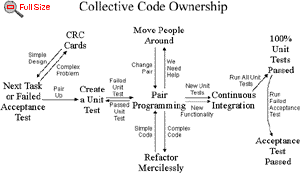 Collective Code Ownership
encourages everyone to contribute new ideas to all segments of the project. Any developer can change any line of
code to add functionality, fix bugs, or refactor. No one person
becomes a bottle neck for changes. Collective Code Ownership
encourages everyone to contribute new ideas to all segments of the project. Any developer can change any line of
code to add functionality, fix bugs, or refactor. No one person
becomes a bottle neck for changes.
 This is hard to understand
at first. It's almost inconceivable that an entire team can be responsible for the system's architecture. Not having
a single chief architect that keeps some visionary flame alive seems like it couldn't possibly work. This is hard to understand
at first. It's almost inconceivable that an entire team can be responsible for the system's architecture. Not having
a single chief architect that keeps some visionary flame alive seems like it couldn't possibly work.
 But it is not uncommon to
ask a chief architect a question and get an answer that is just plain wrong. It is not a failing of your lead programmers.
Any non-trivial system can not be held in one person's mind. Other programmers are hard at work changing the system
without benefit of the architect's vision. Whether you realize it or not your architecture is already distributed
among your team. If the entire team already has some responsibility for architectural decisions, shouldn't they
receive the authority But it is not uncommon to
ask a chief architect a question and get an answer that is just plain wrong. It is not a failing of your lead programmers.
Any non-trivial system can not be held in one person's mind. Other programmers are hard at work changing the system
without benefit of the architect's vision. Whether you realize it or not your architecture is already distributed
among your team. If the entire team already has some responsibility for architectural decisions, shouldn't they
receive the authority
as well?
 The way this works is for
each developer to create unit tests for their code as it is developed. All code that
is released into the source code repository includes unit tests. Code that is added, bugs as they are fixed, and
old The way this works is for
each developer to create unit tests for their code as it is developed. All code that
is released into the source code repository includes unit tests. Code that is added, bugs as they are fixed, and
old |

functionality as it is changed will be covered by automated testing. Now you can rely on the test suite to watch
dog your entire code repository. Before any code is released it must pass the entire test suite at 100%.
 Once this is in place anyone
can make a change to any method of any class and release it to the code repository as needed. When combined with
frequent integration developers rarely even notice a class has been extended
or repaired. Once this is in place anyone
can make a change to any method of any class and release it to the code repository as needed. When combined with
frequent integration developers rarely even notice a class has been extended
or repaired.
 In practice collective code
ownership is actually more reliable than putting a single person in charge of watching specific classes. Especially
since a person may leave the project at any time. In practice collective code
ownership is actually more reliable than putting a single person in charge of watching specific classes. Especially
since a person may leave the project at any time. 
   |